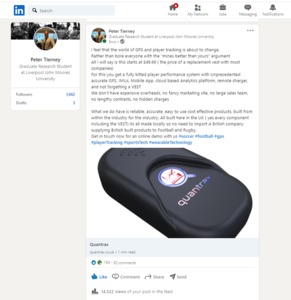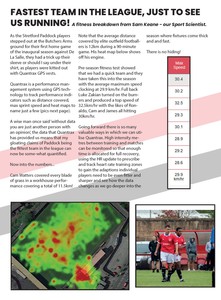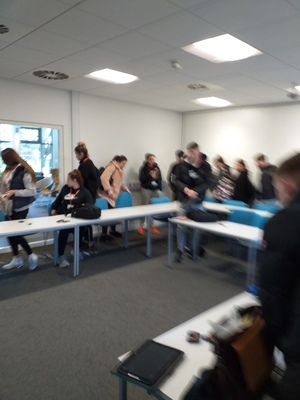Tierney, Peter (2021) Design, Development and Implementation of Wearable Technology in Football Further Education Settings in the United Kingdom. Dataset. [Data Collection]
Abstract
The prevalence of wearable technology in association football (or soccer) has been prominent in top professional teams for over a decade and is employed by coaches and sport science practitioners to
quantify and help improve the performance of either the individual player or team. Educational settings have also witnessed an exponential rise in the application of wearable technology in formal
learning environments. The increased number of football industry related qualifications offered by Further Education (FE) and Higher Education (HE) establishments has probably been the driver for this
expansion. There is, however, a dearth of research on the educational application of wearable technology in FE and HE. There is also some conjecture as to whether the current wearable technology products on the market, are designed for an educational purpose. The aim therefore of this professional doctorate project was to investigate the use of wearable technology in football related further and higher education settings, and to develop a wearable technology product tool that was deemed appropriate for a FE environment. Thus, the aim of Study 1 (Chapter 4) was to establish the extent, wearable technology was being used in FE and HE environments. Using a mixed-method
research design the initial survey established the type of technology and how they were being employed in FE and HE settings. The study identified that Global Positioning System (GPS) vests and Heart rate chest strap are the most prominent wearable technology. Qualitative findings suggested there are pedagogic challenges and barriers to using this kind of technology, a lack of understanding, and poor feedback and communication. Having established some preliminary findings Study 2 (Chapter 5) explored these barriers and challenges within contextualised settings in more depth. It identified a disconnect between 2 coaching performance and coaching education, highlighting a lack of knowledge surrounding the uses and capabilities of wearable technology used in football related FE settings. Furthermore, participant responses suggested the current wearable technology products on the market were not fit for educational purposes. By designing and developing (Study 3) a bespoke wearable technology product (Chapter 6) provided an industry specific solution to the issues
presented in Chapter 5. Adopting a unique collaboration between academia and industry, recruiting experts in various fields, thus enabled the design and development of a novel bespoke system,
including the hardware and software requirements reported in Chapter 4 and Chapter 5. Since the purpose of Study 3 was the development of the wearable technology hardware and software, the aim of Study 4 (Chapter 7) was to evaluate the product and system in an applied real-world setting. Findings suggest student engagement increased, and attainment improved. Additionally, it also demonstrated a more accessible and user-friendly platform for use in FE by eliminating technological features captured in Chapter 5. By using a mobile application and cloud-based system that enabled cross pollination to other curriculum areas suggested college staff and coaches were becoming more engaged with wearable technology. Evidence also suggested students displayed attributes of independent learning and demonstrated engagement outside of formal learning environments. In
summary, the research data and product development presented in this thesis suggest the wearable technology system is fit for purpose and can be deployed in FE environments. From a practitioner
perspective, this doctoral thesis has also laid the foundations for education, football, and wearable technology communities the impetus to work in collaboration. This doctoral thesis demonstrates that
it is possible for academia, business and commercial enterprise to work collectively to elucidate and solve real world industry problems
| Creators: | Tierney, Peter | ||||
|---|---|---|---|---|---|
| Uncontrolled Keywords: | wearable technology | ||||
| DOI: | https://doi.org/10.24377/LJMU.d.00000107 | ||||
| Division: | Sport & Exercise Sciences | ||||
| Field of Research: | Health sciences > Health services and systems > Digital health Health sciences > Sports science and exercise |
||||
| Date Deposited: | 15 Nov 2021 16:21 | ||||
| Last Modified: | 09 Feb 2024 10:49 | ||||
| Related resources: | |||||
| URI: | https://opendata.ljmu.ac.uk/id/eprint/107 | ||||
| Resource language: | English | ||||
| Metadata language: | English | ||||
| Collection period: |
|
Download
Explore Further
Read more research from the creator(s):
Find other related resources:
- https://doi.org/10.24377/LJMU.t.00015733 (Published thesis)

![[img]](https://opendata.ljmu.ac.uk/107/10.hassmallThumbnailVersion/Appendix%2016.linkedin%20profile.png)

![[img]](https://opendata.ljmu.ac.uk/107/12.hassmallThumbnailVersion/Appendix%2017.linkedin%20post.png)

![[img]](https://opendata.ljmu.ac.uk/107/91.hassmallThumbnailVersion/Appendix%2076.Non%20league%20football%20use.jpg)

![[img]](https://opendata.ljmu.ac.uk/107/102.hassmallThumbnailVersion/Appendix%2081.%20FE%20students.jpg)

